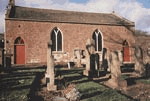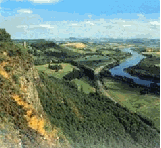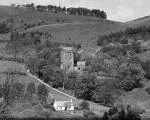|
|
|
|
|
|
|
Visit Kinnaird On A Highly Personalized
Small Group Tour Of My Scotland.
There are many Kinnairds in Scotland, the name meaning merely the head of the height. But there is only one actual parish and village of the name. It is one of those picturesque little communities which nestle in the south-facing folds of the Carse Braes, overlooking the plain of Tay and Gowrie, standing about two miles west of Inchture. Here there is a quite delightful little village, with parish church and manse, all overlooked and dominated by a tall castle. The parish rises from the 5o-foot level in the carselands almost to the 1000-foot contour at Blacklaw; so there is much of climbing, green hillsides, hanging woods and splendid vistas. There was formerly another village at Pitmiddle, much higher on the Braes, to the north-east about a mile; but this, like a number of other Gowrie villages has dwindled into obscurity with the draining of the level plain, and the roads in consequence tending to abandon the heights. There is still a large wood of that name.
Kinnaird village itself sits on broken hillside terraces beside the ravine of its own burn, facing south amongst its orchards, with no village street or scheme of lay-out, but no less attractive therefor. Some of the cottages still retain their thatched roofs. The church dates only from 1815, and is a plain but pleasing building of red stone, with a watch-house; presumably it was necessary to counter the activities of body-snatchers even in this peaceful and arcadian spot. The Threipland of Fingask burial-place flanks the church door.
Kinnaird Church was built in 1815. Since then the interior has been refurbished, with the pulpit being altered, and the windows have been reglazed. The church has an associated session house. The rubble-built sandstone church has a simple bellcote at its west gable. In the south wall are two Y-tracery, pointed arched windows flanked by pointed arched doorways. There is a small cross finial at the east gable. Built into the outside south wall of the church are two mural tablets. One of them commemorates Alexander Wright who died in 1789.
Kinnaird Castle, not to be confused with the much larger seat of that name in Angus, is much more in evidence here than is usual, not hidden away in any large wooded estate but soaring impressively on an open green knoll above the village, still occupied and in good order. It is an interesting and dramatic place, a tall, red-stone keep of the 15th century with earlier nucleus, thick-walled, with a small projecting tower or buttress at one corner, which is not a stair-tower, as it seems, and highly unusual, its summit forming a watch-chamber at high parapet level. Another unusual feature is the two-storeyed 17th century addition to the east-for this is not actually attached to the keep. It contains an old kitchen with an enormous arched fireplace 13 feet wide by 6 deep, with an outside service window, evidently for viands to be pushed through for the castle's family. Hot dishes cannot have been a specialty at Kinnaird.
It is claimed that one Randolph Rufus obtained, from William the Lyon, these lands in 1170; and his descendants took their name therefrom. One, Sir Richard Kinnaird of that Ilk, married his son Reginald to the heiress of Sir John Kirkcaldy of Inchture, and so gained these neighbouring carselands, in the time of Robert III. Just when the Kinnairds moved to live at Moncur Castle, nearer Inchture (now itself a ruin and abandoned by them for Rossie Priory in the vicinity) is not clear. But Sir Patrick Threipland, 1st Baronet of Fingask, bought Kinnaird in the 17th century. Just beforehand, in 1617, James VI on a rare return visit to Scotland, spent some days hunting from here. Later the castle became ruinous, but happily was restored towards the close of the last century.
If you would like to visit this area as part of a highly personalized small group tour of my native Scotland please:
e-mail me today.
Or why not visit my extensive
Travel Scotland
Web site at:
Travel Scotland
|
|
|
|
|
|








